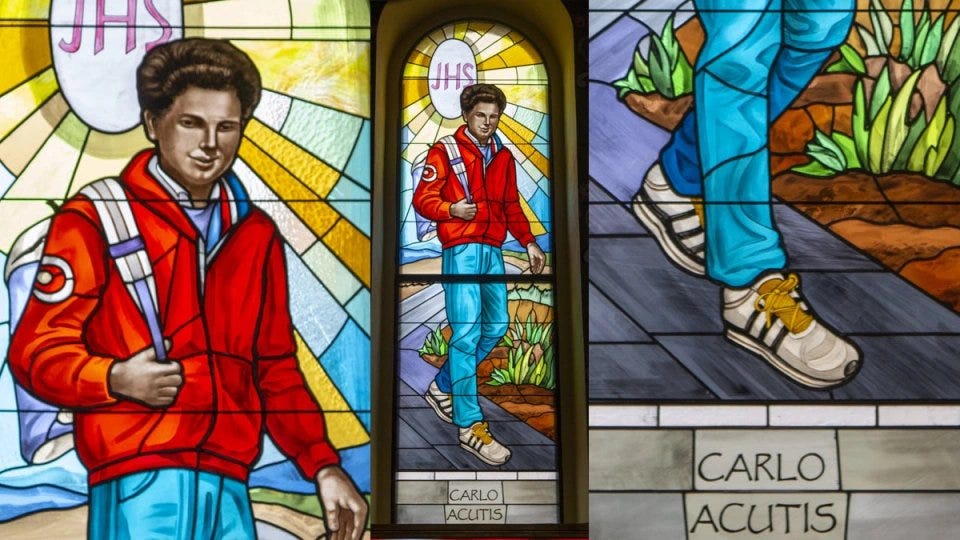Casual Saints and The De-Mythologizing of the Church
An artistic representation of Bl. Carlo Acutis is stirring up controversy, but the real problem lies deeper within the modern Catholic mind.
The following is a paid subscribers-only post with free preview. If you’d like access to all subscribers-only features and posts, you can sign up for just $8/month or $80 per year, right here:
Writing is how I make my living, so if you like what you see here, please support my work by subscribing!
If you’ve already subscribed but would like to buy me a coffee to help keep me fueled up for writing, you can do that at the button below:
Or alternatively, if you’d like you can drop a tip in my PayPal. Thanks for your support!
I've been seeing a lot of hot takes about a recently-revealed stained glass image of Blessed Carlo Acutis.
To be honest, I don’t know much about him. I can tell you that he is a contemporary figure on a fast-track to sainthood. A 15-year old Italian boy of real faith and devotion who died of leukemia. What I’ve seen that appears to attract people to him was his normalcy and relatability. He was devout, but also a normal teenage boy. He was gifted when it came to working with computers. He made websites and played video games.
I’ve often thought of how unrelatable the lives of many saints are. I have at times felt pretty depressed at the idea that I could never be like them, because their acts, faith, and devotion were so extraordinary that they felt unattainable for normal people. A project idea I had a couple years ago, but never got very far into, was trying to identify a collection of saints who were the most relatable, the most like us, and present them for consideration and inspiration.
What Carlo Acutis does is scratch that itch. He wasn’t a miracle worker. He didn’t do extreme acts of penance, or go toe to toe with the devil in physical combat. He didn’t suffer the horrific torments of martyrdom (although Leukemia is no easy way to go.) He loved God, he went to Mass as often as he could, he attended to the duties of his state in life, and he had his priorities in order. A life like that makes it appear possible for normal folks just trying to do their best to live their faith and still be in the world to actually become saints.
But his representation in a new piece of sacred art presents him as the normal kid I’m describing, wearing a backpack, jeans, and sneakers. And that image has proven rather controversial.
It should be noted that the stained glass depiction is very similar to the way his body has been entombed and displayed:
Brian Holdsworth, a popular figure in Catholic media, does a good job of explaining the objection to this casual depiction without snark or bitterness:


It’s a fair point. But others strongly disagree.
I think it's actually quite normal to see this disparity of reaction. But that’s because I think it points to a deeper sort of unraveling of the Catholic mythos. This demythologizing of the Church, I think, is due not to a “Modernist campaign” to dumb religion down — although there may be some of that mixed in — but rather to a massive shift in perception.
My thoughts on this are still developing, but let me try to explain.
Have you subscribed to The Skojec File yet? It’s only $8 a month, gets you access to our community and exclusive subscriber content. Most importantly, it’s how I support my family and keep providing quality content for you to enjoy!
If you like, you can offer additional support for my work via Paypal or Patreon.
A conclusion I kept arriving at time and again in my work over the past seven years is that we cannot compare our present moment in Church history to any moment in the past for the simple reason that our historical context is entirely novel in ways that affect the entire global populace. Namely, the fact that we now live in an information age that is completely unprecedented and would have been wholly unimaginable just a few generations ago.
And because we’re in the thick of it, we’re just not able to fully recognize the uniqueness of our moment in history, and how it has altered our understanding of both current and past events. The technological developments of the past century in particular are absolutely mind-boggling. And we’re often too close to them to even see them. For context, take this image Times Square (then known as Longacre Square) in New York, taken around the year 1900:






